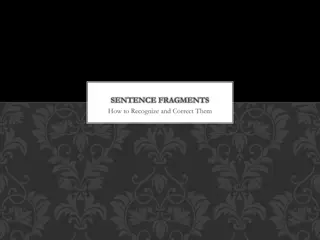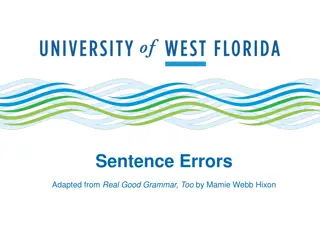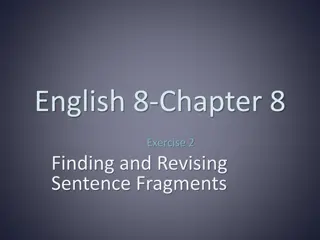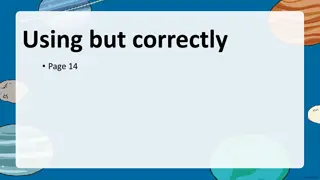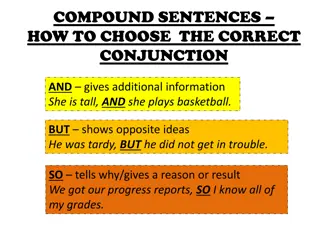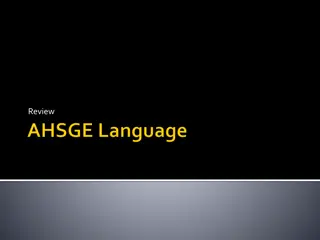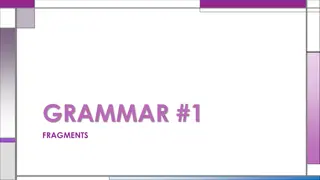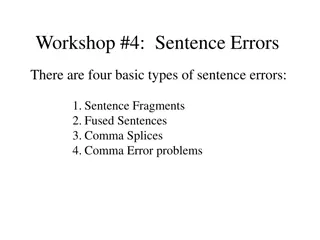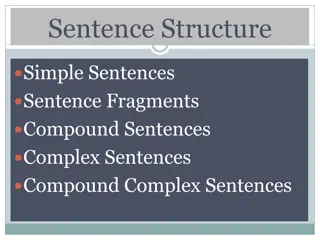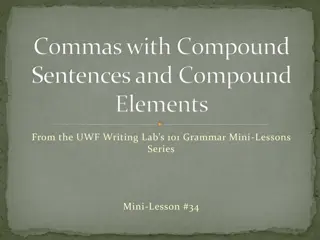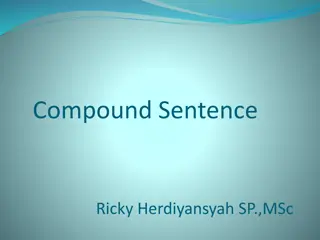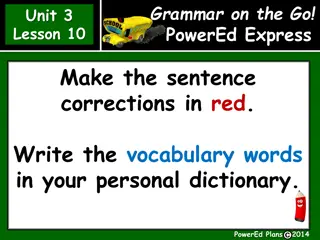Mastering Sentence Structure: From Fragments to Compound Sentences
Learn how to avoid sentence fragments and craft cohesive, compound sentences. Understand the difference between simple and compound sentences, and discover the importance of coordinating conjunctions in writing. Enhance your SAT writing skills with practical examples and exercises to improve sentence structure proficiency.
Download Presentation

Please find below an Image/Link to download the presentation.
The content on the website is provided AS IS for your information and personal use only. It may not be sold, licensed, or shared on other websites without obtaining consent from the author. Download presentation by click this link. If you encounter any issues during the download, it is possible that the publisher has removed the file from their server.
E N D
Presentation Transcript
GRAMMAR: SAT WRITING SUCCESS
AVOIDING SENTENCE FRAGMENTS A sentence fragment is an incomplete sentence. A sentence must include at least one subject and verb and must form a complete thought. If it does not, then it is a fragment!
SAMPLE FRAGMENTS The neighbor s cat. Was grumpy. Because I like to swim.
SENTENCE OF FRAGMENT? 1. Interest in building a canal across the Isthmus of Panama. 2. The usefulness of such a canal for sea trade. 3. Now that the United States was a power in both the Caribbean Sea and the Pacific Ocean. 4. What is now Panama was a northern province of Colombia.
SENTENCE OR FRAGMENT? CONTINUED 5. When the Colombian legislature refused to ratify a treaty. 6. Giving the United States the right to build and manage a canal. 7. Panama granted the U.S. a lease in return for $10 million and a yearly fee of $250,000. 8. The completion of the canal in 1914 was a major triumph.
SENTENCE OR FRAGMENT ANSWERS NO CHEATING! SF 1. SF 2. SF 3. S 4. SF 5. SF 6. S 7. S 8.
Simple Sentence= independent clause One subject and one verb Compound Sentence = two or more simple sentences (independent clauses) You form compound sentences by combining two independent clauses with a coordinating conjunction preceded by a comma.
USING COORDINATING CONJUNCTIONS European immigrants arrived at Ellis Island. European immigrants arrived at Ellis Island, but Asian immigrants arrived at Angel island. A comma alone cannot connect two independent clauses!
COORDINATING CONJUNCTIONS And But Or For Nor So Yet
Coordinating conjunctions show the relationship between two ideas.
ADDING THE COMMA It always goes BEFORE the conjunction! We can stand in line all night, or we can go home now. But remember, only use a comma if it connects two COMPLETE INDEPENDENT CLASUES! Incorrect: We can stand in line all night, or go home now. Correct: We can stand in line all night or go home now.
SEMI-COLONS You can also join two simple sentences with a semicolon (;) The train went by very quickly; I could barely read where it was from.
USING TRANSITIONAL WORDS AND PHRASES When you use a transitional word or phrase to join two sentences, a semi-colon always goes before the transitional word or phrase, and a comma always comes after it. Example: Some college students receive grants; however, others must take out student loans. Example: He had a miserable time at the party; in addition, he lost his wallet.
FREQUENTLY USED TRANSITIONAL WORDS Also Besides Consequently Eventually Finally Furthermore However Instead Later Meanwhile Moreover Nevertheless Now Otherwise Still Subsequently Then Therefore Thus
FREQUENTLY USED TRANSITIONAL PHRASES After all In comparison As a result In contrast At the same time In fact For example In other words For instance Of course In addition On the contrary
YOU CAN CREATE COMPLEX SENTENCES BY USING Dependent clauses Subordinating clauses or Relative pronouns
IDENTIFYING COMPLEX SENTENCES An independent clause can stand alone as a sentence. However, a dependent clause cannot stand alone as a sentence. When you add the dependent clause to the independent clause, the result is a complex sentence.
SAMPLE COMPLEX SENTENCE: Because the art exhibit was controversial, many people came to see the paintings. The part that is italicized is the independent clause, the rest is the dependent clause (it can not stand on it s own, it is a fragment).
PRACTICE: INDEPENDENT CLAUSE (IC) OR DEPENDENT CLAUSE (DC) Example: The American diner began as a covered horse- drawn lunch wagon. IC 1. When lunch wagons added stools and counters in the late 1800 s. 2. Some expanded lunch wagons had fancy woodwork and glass. 3. Because of laws that restricted operating hours. 4. Lunch wagon operators started opening diners.
5. The name diner came from railroad dining cars. 6. Because some diners were converted railroad cars. 7. Diners added bathrooms, booths, and landscaping in the 1920 s. 8. Even though many diners moves from cities to suburbs after WWII.
9. Diners later competed with fast-food restaurants by adding brick walls and shingled roofs. 10. Who by the 1980 s made railroad-style diners popular again in the United States and Europe.
PRACTICE- ANSWER CHECK IC DC IC DC DC IC DC IC IC 1. 2. 3. 4. 5. 6. 7. 8. 9. 10. DC
USING SUBORDINATING CONJUNCTIONS Subordinate means to be lower in rank of position; secondary in importance. One way to form a complex sentence is to use a subordinating conjunction- a word like although or because- to join two simple sentences (independent clauses). Independent clause contains the more important idea.
SAMPLE COMPLEX SENTENCE WITH SUBORDINATING CLAUSE: Although Muhammad Ali was stripped of his heavyweight title for refusing to go into the army, many people admired his antiwar position. Which part is the subordinating clause?
SAMPLE COMPLEX SENTENCE WITH SUBORDINATING CLAUSE: At the beginning of the track-and-field events, Jesse Owens felt tense because a German had won a gold medal the day before and received Hitler s enthusiastic congratulations. Which part is the subordinating clause?
FREQUENTLY USED SUBORDINATING CONJUNCTIONS After Although As As if Because Before Even if Even though If If only In order that Now that Once Provided that Rather than Since So that Than Though Unless Until When Whenever Where Whereas Wherever Whether While
SUBORDINATING CONJUNCTIONS THAT SHOW A RELATIONSHIP IN TIME After Before Since Until When Whenever While Sample: When the whales surfaced, Ahab threw his harpoon.
SUBORDINATING CONJUNCTIONS THAT SHOW RELATIONSHIP IN REASON/CAUSE As Because Sample: Scientists scaled back the project because the government cut funds. (Why is there no comma before the word because?)
SUBORDINATING CONJUNCTIONS THAT SHOW A RELATIONSHIP IN RESULT/EFFECT In order that So that Sample: So that student s math scores will improve, many schools have begun special programs.
SUBORDINATING CONJUNCTIONS THAT SHOW A RELATIONSHIP IN CONDITION Even if If Unless Sample The rain forest may disappear unless steps are taken immediately.
SUBORDINATING CONJUNCTIONS THAT SHOW A RELATIONSHIP IN CONTRAST Although Even though Though Sample Although Thomas Edison had almost no formal education, he was a successful inventor.
SUBORDINATING CONJUNCTIONS THAT SHOW A RELATIONSHIP IN LOCATION Where Wherever Sample: Pittsburgh was built where the Allegheny and Monongahela Rivers meet.
SUBJECT-VERB AGREEMENT Problem sentences: Jane want to hear from you. Janes wants to hear from you. The Rule: Usually an s follows either the subject or the verb, but not both. (an exception might be: Charles wants to hear from you).
A sentences subject (a noun or a pronoun) and its verb must agree: singular subjects take singular verbs, and plural subjects take plural verbs. Example: The museum opens at ten o clock. (singular noun takes a singular verb) Example: The museums open at ten o clock. (plural noun subject takes a plural verb)
Singular Plural First Person I play Molly and I/ we play Second Person You play You play Third Person He/she/it plays They play The man plays The men play Molly plays Molly and Sam play
COMPOUND SUBJECTS The subject of a sentence is not always a single word. It can also be a compound subject, made up of two or more words. Rules: When the parts of a compound subject are connected by and, the compound subject takes a plural verb. Rules: When the parts of a compound subject are connected by or, the verb agrees with the part of the subject that is closer to it.
RULES: WHEN THE PARTS OF A COMPOUND SUBJECT ARE CONNECTED BY AND, THE COMPOUND SUBJECT TAKES A PLURAL VERB. John and Marsha share an office. The dog and the cat play nicely in the yard.
RULES: WHEN THE PARTS OF A COMPOUND SUBJECT ARE CONNECTED BY OR, THE VERB AGREES WITH THE PART OF THE SUBJECT THAT IS CLOSER TO IT. The mayor or the council members meet with community groups. The council members or the mayor meets with community groups.
BE, HAVE, DO Irregular verbs in the present tense. They can present problems with subject-verb agreement. Memorizing their forms is the ONLY sure way to avoid such problems.
SUBJECT-VERB AGREEMENT WITH BE Singular Plural First Person I am We are Second Person You are You are Third person He/she/it is They are Tray is Tray and Ryan are The boy is The boys are
SUBJECT-VERB AGREEMENT WITH HAVE Singular Plural First Person I have We have Second Person You have You have Third Person He/she/it has They have Shana has Shana and Robert have The student has The students have
SUBJECT-VERB AGREEMENT WITH DO Singular Plural First Person I do We do Second Person You do You do Third Person He/she/it does They do Ken does Ken and Mia do The book does The books do
WORDS BETWEEN SUBJECT AND VERB Don t be confused when a group of words comes between the subject and the verb. They do NOT affect subject-verb agreement. You can always cross out the words that come between the subject and verb to ensure they agree. High levels of mercury occur in some fish. Water in the fuel lines causes an engine to stall. Food between the teeth leads to decay.
COLLECTIVE NOUN SUBJECTS Collective Nouns are words (such as family and audience) that name a group of people or things but are singular. Because they are singular, they always take singular verbs. The team practices five days a week in the gym.
FREQUENTLY USED COLLECTIVE NOUNS Army Corporation Association Family Band Gang Class Government Club Group Committee Jury Company Mob Team Union

 undefined
undefined











